Investing into iPhone App Development: What’s the Gain?

IT copywriter
Reading time:
If you’ve come up with a concept for a great new app, you might be eager to hire a development team and have the app released as soon as possible, before competitors. However, before you jump to application development, it is a good idea to think ahead and make some estimations: will you get a reasonable return on iPhone app development investments once the app is released?
How do you estimate the revenue? The formula is quite simple: downloads * monetization coefficient. The variables, however, aren’t so straightforward. Take the monetization coefficient, for example, which is how much money one installation brings. For paid apps with no in-app purchases, it’s simply the price minus Apple’s 30%, but a paid app will not necessarily bring you more money since in general a free app is downloaded 15-20 times more often than a paid one.
If the installation of a free version could bring you more than 10 cents you should consider making your app free, if more than a dollar, then you should definitely make it free. The average free-to-paid conversion is about 4%.
Next, let’s look at downloads. The probability that your app will be downloaded depends on the following:
- Will the app make it to App Store Charts, whether it’s Top Apps Paid, Free or сategory section. Ironically enough, this depends on the number of downloads: according to App Annie in USA an app should make 13,000 download daily to be in Top 100 Free Apps for iPhone — we stick strictly to iPhone apps in this article — and 54,000 — to be in Top 10.
- Will it be selected to New and Noteworthy or Featured App promotions.
- Competitors. According to Xyologic’s March 2013 Report, that covers a period from March 8, 2013 to April 9, 2013, 30,815 apps appeared in App Store for iPhone users in USA. 22,746 of these apps are free and 8,089 — paid. This figure of potential competitors might be even lower if we narrow results to a specific category.
The most competitive categories in March 2013 were Games with 5,617 new apps and Education — 1,168 apps and Business — 3,091. The number of new apps in other categories varies from approximately 3,000-1,000 (Travel, Lifestyle, Utilities, Sports, Health) to 900-800 (Music, Food, Photography).
Diagram 1. New apps category statistics from March 8, 2013 to April 9, 2013
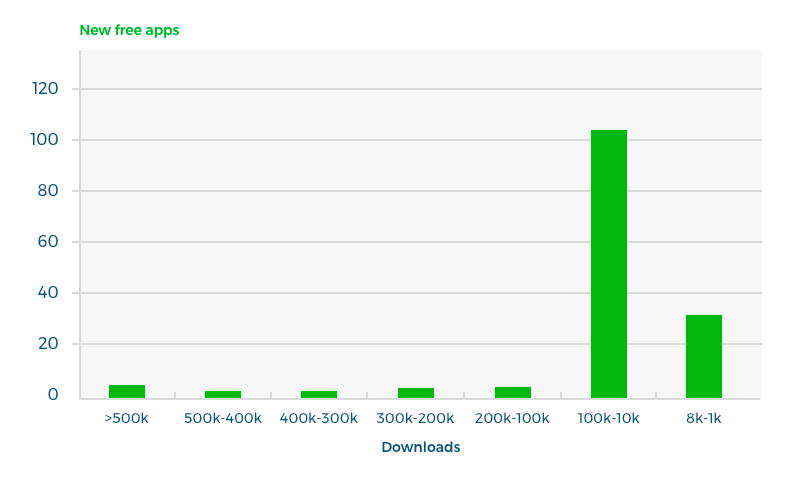
- Marketing strategy.
Now some real figures. Xyologic’s March 2013 Report exposes its own Top 150 iPhone new paid apps, where apps are ranked by the number of downloads they‘ve generated. The 150th paid app PhotoCal with Event by YunaSoft Inc. reached 2,100 downloads, which means that more than 7,939 new paid apps in App Store were downloaded less than 2,200 times if at all once this March.
The 1st three places gained 308,600 (Super Stickman Golf 2 by Noodlecake Studios Inc.), 203,700 (Ridiculous Fishing – A Tale of Redemption by Vlambeer), and 47,600 (Slayin by FDG Entertainment) downloads respectively.
Diagram 2. New paid apps download statistics. Xyologic shows that only 3 new paid apps were downloaded more than 200 000 times and just one of them more than 300 000 times from March 8, 2013 to April 9, 2013
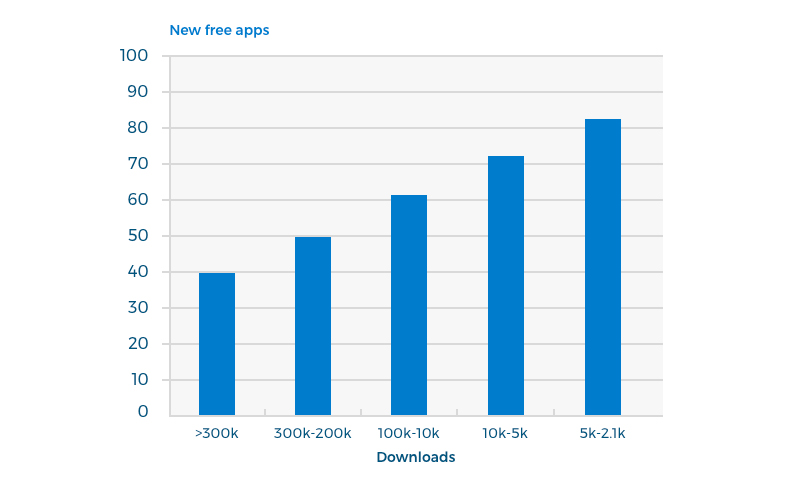
Diagram 3. New free apps download statistics. Xyologic shows that only 4 new free apps were downloaded more than 500 000 times from March 8, 2013 to April 9, 2013
How to increase the revenue?
Let’s make a rough calculation. Say, you’ve done standard promotion gaining 2,400 downloads for the first month and set the 0.75 € price, the most popular price in Xyologic’s Top 150 list. What we get is 1 824 € minus Apple’s 30% per month. But this revenue could be much higher. Below you’ll find several considerations to start your journey to a smart and profitable strategy.
Choose App Store category wisely
Often times, the most obvious choice is not the best one. It might be smart to avoid the obvious most popular category, opting for a smaller, less popular category instead. By choosing a category that has fewer apps, you can decrease your competition and have a better chance to get to App Store Charts. But beware of picking a category only because of its size.
The best way to get your app noticed is to place it into a category where most users will think to search. Before submitting your app to App Store, take a good look at potential competitors, i.e. similar apps: what categories they are located in and how well are they doing in those categories.
Diagram 4. Xyologic’s new paid apps category statistics from March 8, 2013 to April 9, 2013
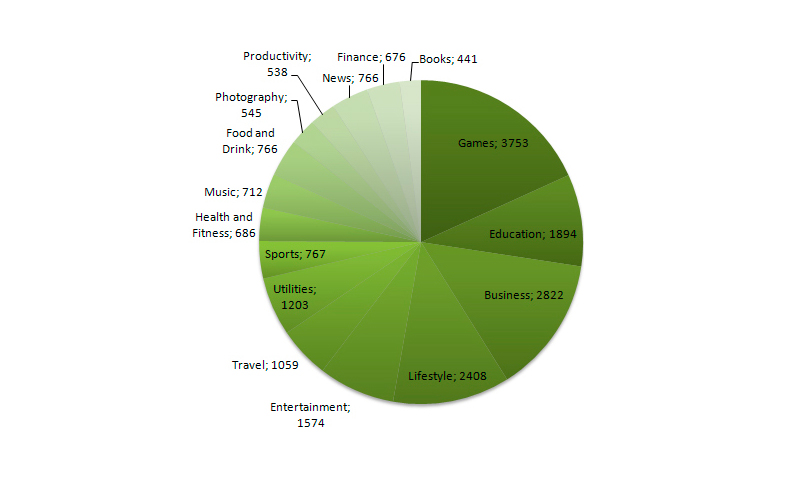
Diagram 5. Xyologic’s new free apps category statistics from March 8, 2013 to April 9, 2013
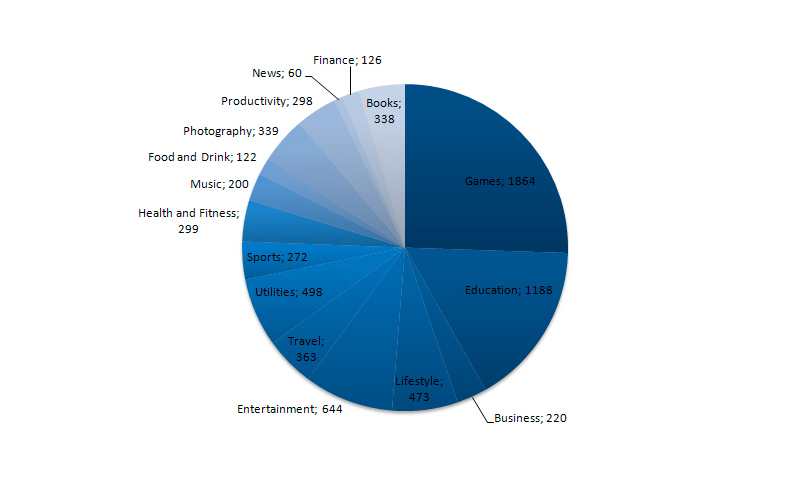
Make Apple want to showcase your app as a Featured App
If your app makes it to Apple’s Featured list, you can already consider the app successful. But if you want Apple to showcase your app, you have to not only make the app look good, but make the iPhone look good too. In other words, if Apple can use your app to show off the iPhone’s cool features, they’re much more likely to feature your app.
So, monitor new iPhone SDKs for new device functions and make use of it in your applications. A good illustration of this concept is the constant presence of location-aware apps in Featured App sections during the time when GPS was iPhone’s new feature.
Appear in search
App Store optimization (ASO) is a vast topic, not to mention it being a complete black box that no one seems to understand completely. All we can advise is to stay on guard, since starting from summer 2012 Apple has been tweaking App Store optimization algorithms. The changes seem not that drastic and almost unnoticeable for users (a couple of apps disappearing and reappearing in the search results), but meaningful for developers.
For instance, the App Store might suddenly start ranking results higher by user ratings, comments, and descriptions, rather than names of apps, and then go back to previous rankings. This indicates to us that Apple is doing some experimenting with the App Store’s search. While Apple is still on the quest for the perfect search algorithm, stay tuned, monitor changes and be prepared to experiment with tactics and strategy.
Get the largest number of users possible
Reducing the app price to free for a day or two can help move your application higher in App Store Chart, especially if you notify popular giveaway sites of this limited-time offer. Another way to expand your customer base is to take advantage of social platforms. By integrating a third-party social platform (like Scoreloop or Plus+) into your iPhone app, you’re not just saving hours of development time, but enter powerful environment for increased app discovery.
When choosing a social platform, there is a vital issue to consider: platform that is being adopted by popular apps will attract a larger audience, or put simply offers a higher exposure chance for your app. The down side is that your app should be more fun and thrilling than competitors’ to grab the user’s attention. Only in this case users’ enthusiasm will become visible in online social community and drive additional sales.
Make the most from your competitors
The mistakes of others hurt less but teach a lot. Here are some ideas for a close study of your competitors:
- get competitors statistics
- search for customer reviews
- read submission rejections
- study alternative app directories
- analyze rank statistics
And don’t forget about those competitors whose apps are only available in other countries.
Don’t abandon apps
If you don’t want your product pages sink in angry customer reviews, never abandon apps. Sometimes after releasing you might want to develop something quite different but leaving a half-baked app behind, you might compromise your company’s reputation and the future of any new apps you produce. Be passionate about any app of yours and continue to maintain it in the long run, making customers happy and building strong relationship with them built on trust and satisfaction.
What waits ahead
There’s no getting around it: the mobile industry has the power to reshape the world of retail, entertainment, and business. According to Gartner, by 2015, mobile application development projects will outnumber desktop projects by a ratio of 4-to-1. You are on the right path having chosen to develop mobile apps, now it’s vital to opt for the right direction. Appcelerator has some prediction as to which apps will rise or decline in 2013, based on changes between Q4 2010 and Q4 2012.
The following categories will be in focus of 2013: Business (20.3% increase since Q4’10), Finance (8.2% increase since Q4’10), Education (8.1% since Q4’10), Medical (8% increase since Q4’10), Productivity (7.8% increase since Q4’10) and Mobile Money (6.6% increase since Q4’10).
Although the answer to the title question has turned out to be quite vague, that’s how it really is: you never know until you try. But releasing an app doesn’t mean leaving it alone and waiting for whatever happens, subjected to the forces of App Store. The app’s release is only the beginning of a journey, a difficult but exciting one, where good tools, knowledge, and sanity checks make a big difference. Take care while you’re on this journey and good luck with the sales.
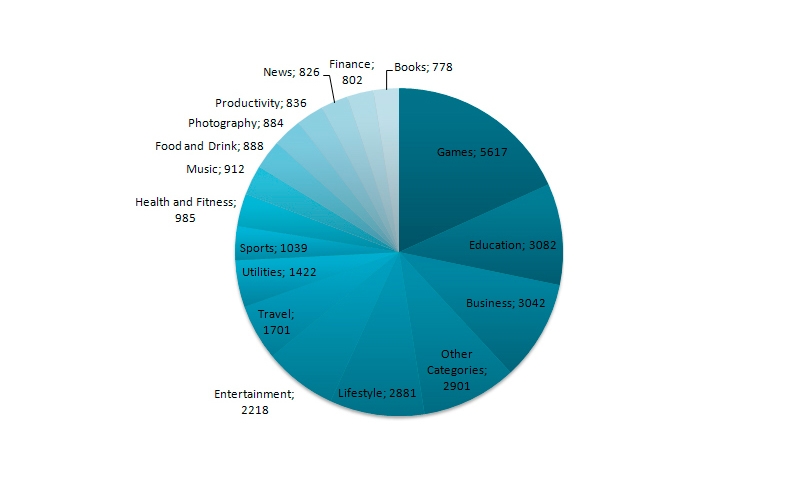


Comments